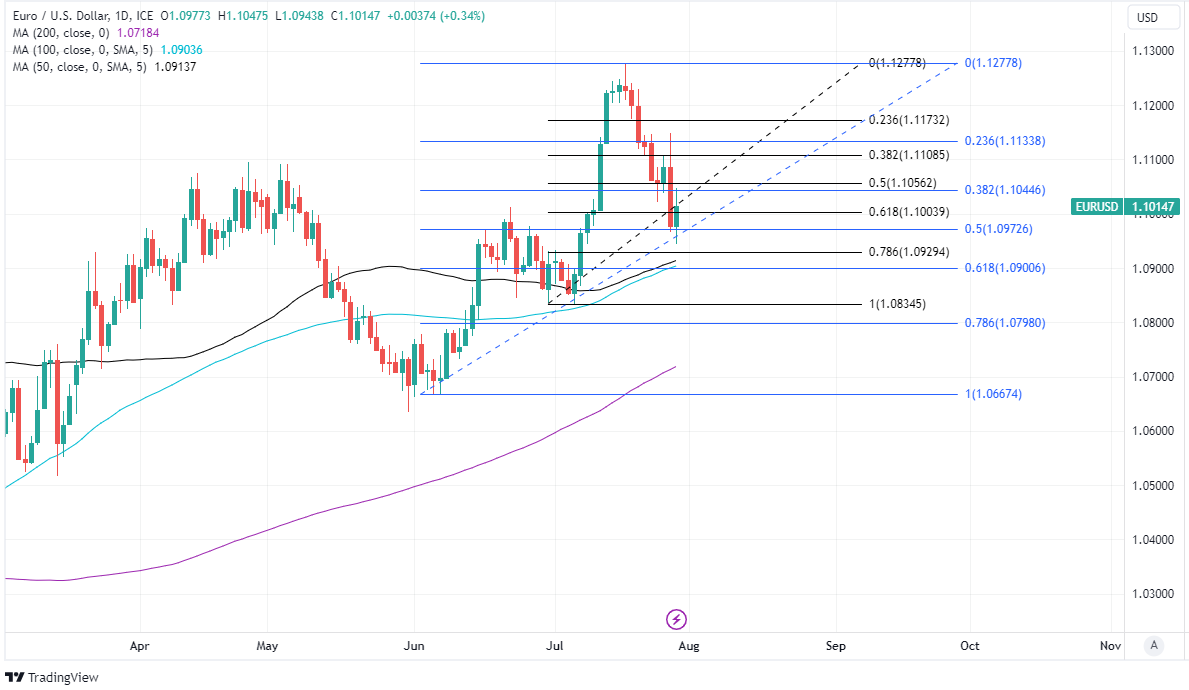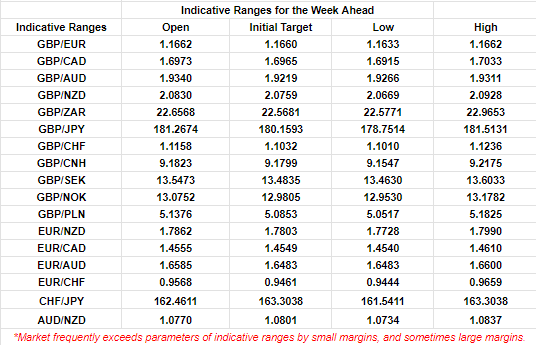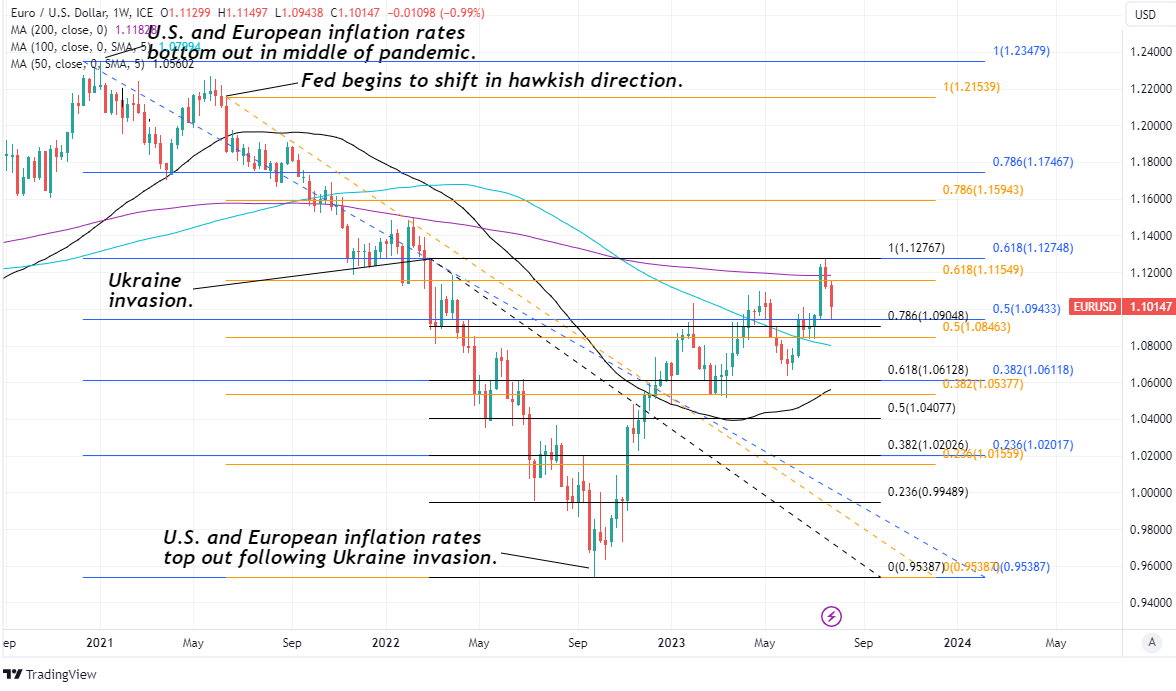EUR/USD Week Ahead Forecast: Supported at 1.09 as Data Deluge Eyed
- Written by: James Skinner
- Rough 1.0913-1.1150 range possible for EUR/USD
- Underpinned by multiple chart supports short-term
- Could face resistance at 1.1274 near medium term
- Imminent EU inflation figures, ECB outlook in focus
- U.S. PMIs, non-farm payrolls & other job data eyed

Image © European Central Bank
The Euro to Dollar exchange rate has reversed much of its July rally but is underpinned by a dense cluster of technical supports immediately below the market and could have scope for a recovery to 1.1150 this week European inflation figures and U.S. labour market measures permit.
A strong real-terms annual increase in Japanese retail sales for June was followed by a better-than-expected reading of the China Federation of Logistics and Purchasing (CFLP), Purchasing Managers' manufacturing PMI on Monday with both helping to dampen appetite for the Dollar and support the Euro early in the new week.
A buoyant Asia Pacific trading session helped the single currency hold onto the 1.10 level against the greenback in early European trade but the prospects of the Euro-Dollar rate going forward will be shaped substantially by the imminent release of continental inflation figures for the month of July.
“The ECB’s tone has changed decisively. Intransigent forward guidance is gone; data dependency is in. What does this transition mean for the path of European interest rates and the euro?” asks Mathieu Savary, chief European strategist at BCA Research, in a Monday research briefing.
“Activity data do not warrant further interest rate hikes, especially if inflation continues to trend lower. Only an upside surprise in inflation will force the ECB to lift rates again in September. Nonetheless, for the next six-to-nine months, the downside to the ECB’s policy rate is limited because growth data will stabilize,” he adds.
Above: Euro to Dollar rate shown at daily intervals with selected moving averages and Fibonacci retracements of recent uptrends indicating possible areas of technical support.
The consensus among economists favours a further decline in the main European inflation rate on Monday from 5.5% to 5.3% for the current month though the more important core inflation rate - which excludes items like energy and food from the goods basket - is seen declining by less from 5.5% to 5.4%.
Any stubbornness or stickiness in either of the inflation rate would potentially be problematic for the European Central Bank (ECB) and particularly if accompanied by further indications of weakness in Eurozone economic growth when GDP data for the second quarter.
The latter is released at the same time and is tipped to illustrate a -01% contraction from the prior period being reversed with a 0.2% increase owing itself in part to the pickup in French consumer spending reported on Friday, and a robust performance from the Spanish economy.
“Spain and France grew strongly in Q2, while Germany stagnated. This suggests the euro area could print 0.2% q/q,” says Philippe Gudin, an economist at Barclays. “However, it is hard to identify a common denominator in the drivers of strength of the former group of countries, for which details are available.”
Monday’s European data points are the highlights of the week for the Euro but are followed by a flood of figures from the U.S. including Institute for Supply Management surveys of the manufacturing and services sectors on Tuesday and Thursday, as well as three different measures of labour market health on Tuesday, Wednesday and Friday
“A strong outcome on the core CPI may encourage markets to price in higher odds of a 25bp hike by the ECB at its 14 September meeting and support EUR/USD. However EUR/USD is unlikely to test upside resistance at 1.1276 (100% Fibbo),” says Carol Kong, an economist and currency strategist at Commonwealth Bank of Australia.
Above: Quantitative model estimates of ranges for the week ahead. Source Pound Sterling Live.
“The Federal Reserve’s ‘Senior loan officer opinion survey’ for Q2 2023 will also be important to watch for FOMC policy making (7pm London time). A sharp tightening in US banks’ lending standards can bolster the view the FOMC’s next move in interest rates will be a cut, albeit some months away, and weigh on the USD,” she adds.
Many will pour over the U.S. data closely after second quarter GDP surprised sharply on the upside of economist expectations last Thursday while coming accompanied by an upward revision to first quarter growth and soon after the Federal Reserve (Fed) left its options open in relation to September’s interest rate decision.
But with further falls in the preferred inflation measure of the Fed announced just last Friday it’s possible it would take some meaningful upside surprises in all of the labour market numbers and purchasing manager surveys in order to dislodge the market from its expectation for unchanged interest rates from here.
“EURUSD has similarly corrected sharply lower after being capped as expected at resistance at the 61.8% retracement of the 2021/2022 fall at 1.1275,” writes David Sneddon, a director at Credit Suisse, in a technical analysis presentation last Thursday.
“Below support at 1.1003 suggests there is scope for further weakness yet to the 1.0905/1.0833 support cluster – the rising 55-day average, uptrend from last September and early July lows. This needs to hold to suggest weakness is corrective ahead of strength back to 1.1152 and then a retest of 1.1275/77,” he adds.
Above: Euro to Dollar rate shown at weekly intervals with Fibonacci retracements of selected downtrends indicating possible areas of technical resistance for Sterling. Selected moving averages denote possible support and/or resistances.







